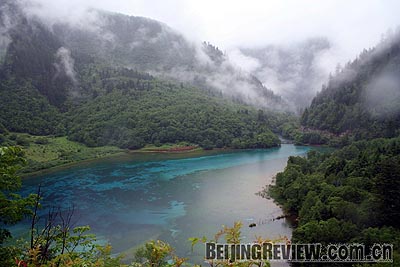|
year for visiting was approaching in Jiuzhaigou; cable cars, restaurants and hotel facilities were sound in the wake of the earthquake; and tourists would enjoy a warm welcome. Even during the earthquake no tourists were injured in Jiuzhaigou, she added.

TRANQUILITY: Jiuzhaigou, a UNESCO World Heritage site, is untouched by the quake
She said of the three highways to Jiuzhaigou, one starting from Chengdu via devastated Beichuan County and another starting from Lanzhou, capital city of Gansu Province, had been reopened, while the other highway from Chengdu via the epicenter of Wenchuan is under repair. Flights from Chengdu to Jiuzhaigou were not disrupted by the quake.
Fan said she expected that Jiuzhaigou would be among the second batch of tourist attractions to be reopened, which will be released soon.
With its rich tourism resources Sichuan ranks first among China's provinces in terms of the number of areas on the World Heritage List of UNESCO and the numbers of state key scenic spots. In 2007, the tourism revenue of the province was 121.73 billion yuan ($17.39 billion), accounting for 10 percent of the provincial total gross domestic product.
Sichuan was more dependent on tourism than any other Chinese province, according to experts.
The damage caused by the earthquake to scenic spots in Sichuan on the World Heritage List varied widely. According to Deng Gongli, head of Chengdu Tourism Administration, Emei Mountain scenic area, including Leshan Giant Buddha, was almost untouched by the earthquake; Jiuzhaigou and Huanglong scenic areas suffered little damage; and Qingcheng Mountain and the Dujiangyan irrigation system suffered severe damage, but were not destroyed.
The giant panda sanctuaries, listed as a world heritage site in 2006, were also severely damaged during the earthquake with one panda killed and one still missing.
Government efforts
According to statistics from Sichuan Tourism Administration, the
| 